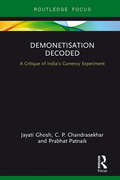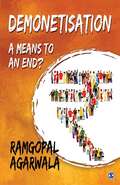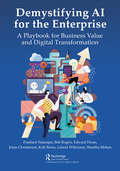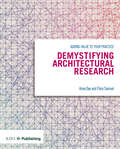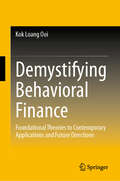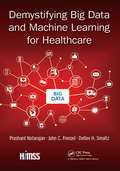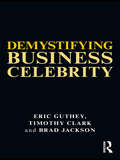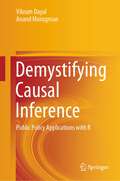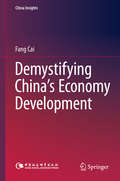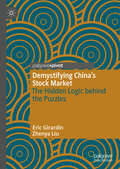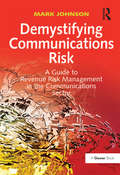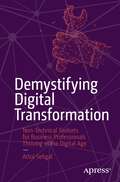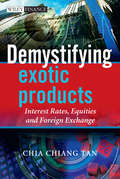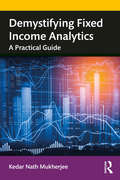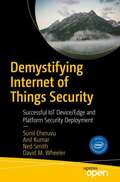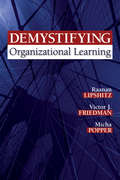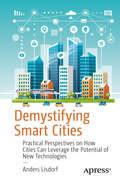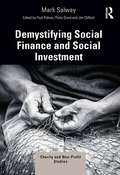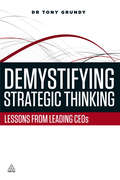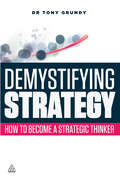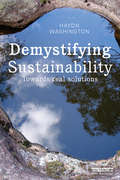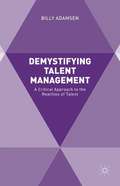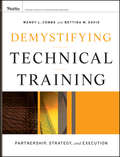- Table View
- List View
Demonetisation Decoded: A Critique of India's Currency Experiment
by Prabhat Patnaik C. P. Chandrasekhar Jayati GhoshOn the night of 8 November 2016, at 8:15 pm, India’s Prime Minister, Narendra Modi, announced in a televised broadcast to the nation that with effect from midnight, currency notes of denominations Rs 500 and Rs 1,000 would no longer be legal tender. In one stroke, this involved the de-recognition of over 86 per cent of the value of Indian currency in circulation with only four hours’ notice. This important book provides a quick and concise explanation of the goals, implications, initial effects and the political economy of this major demonetisation move by the Government of India. It clarifies key concepts and offers astute economic analysis to guide the reader through the various claims, arguments and critiques that have been made; highlights the complexities of the processes that have been unleashed; and examines the likely outcomes in the long term as well as those that are immediately evident. Timely and lucid, this book will interest students and researchers in the fields of economics, finance, management, law, politics and governance as well as policy makers, legislators, civil society activists and the media.
Demonetisation: A means to an End?
by Ramgopal AgarwalaOn 8th November 2016, India was caught unaware and shaken to its very roots, when the majority of the currency in circulation became stripped of its value. People were grappling with an entirely unfamiliar situation - ′demonetisation′. The move unleashed a huge debate on television, in newspapers, and on social media, the likes of which had never been seen. Several months later, we are still questioning: Was this a disastrous blunder or a leap forward? To answer these questions, a renowned economist takes an incisive look at the events that led to demonetisation, the aftermath, and its implications. He sifts through many irrelevant rants, a lot of politically motivated mud-slinging, and asks the most important question: What now, what next?
Demystifying AI for the Enterprise: A Playbook for Business Value and Digital Transformation
by Prashant Natarajan Kirk Borne Leland Wilkinson Bob Rogers Edward Dixon Jonas Christensen Shantha MohanArtificial intelligence (AI) in its various forms –– machine learning, chatbots, robots, agents, etc. –– is increasingly being seen as a core component of enterprise business workflow and information management systems. The current promise and hype around AI are being driven by software vendors, academic research projects, and startups. However, we posit that the greatest promise and potential for AI lies in the enterprise with its applications touching all organizational facets. With increasing business process and workflow maturity, coupled with recent trends in cloud computing, datafication, IoT, cybersecurity, and advanced analytics, there is an understanding that the challenges of tomorrow cannot be solely addressed by today’s people, processes, and products. There is still considerable mystery, hype, and fear about AI in today’s world. A considerable amount of current discourse focuses on a dystopian future that could adversely affect humanity. Such opinions, with understandable fear of the unknown, don’t consider the history of human innovation, the current state of business and technology, or the primarily augmentative nature of tomorrow’s AI. This book demystifies AI for the enterprise. It takes readers from the basics (definitions, state-of-the-art, etc.) to a multi-industry journey, and concludes with expert advice on everything an organization must do to succeed. Along the way, we debunk myths, provide practical pointers, and include best practices with applicable vignettes. AI brings to enterprise the capabilities that promise new ways by which professionals can address both mundane and interesting challenges more efficiently, effectively, and collaboratively (with humans). The opportunity for tomorrow’s enterprise is to augment existing teams and resources with the power of AI in order to gain competitive advantage, discover new business models, establish or optimize new revenues, and achieve better customer and user satisfaction.
Demystifying Architectural Research: Adding Value to Your Practice
by Flora Samuel Anne DyeThis practical, hands on introduction guides you through the basics of undertaking research in day-to-day architectural practice helping you to exploit the growing opportunities on offer. It explores how developing a research specialism can improve the quality of your projects, help to define your brand and generate new channels of revenue with innovative services for clients. The text is divided into four sections focussing on different types of Architecture Research Practice; commercial, cultural, social and technology. Each section includes a series of inspiring case studies written by practitioners themselves on the way in which research benefits their business as well as an essay by an expert which sets these projects in their methodological context. In this way the book highlights the broad spectrum of research being undertaken and the practical implications for the practice and their projects. This is designed for architects and practices who want to develop a clear specialism that adds brand value and will enable them to access new funding streams as well as students of architecture who are getting to grips with architectural research.
Demystifying Behavioral Finance: Foundational Theories to Contemporary Applications and Future Directions
by Kok Loang OoiThis book provides a thorough examination of behavioural finance, charting its development from foundational theories to contemporary applications and future directions. It delves into the psychological underpinnings of investor behaviour, elucidating how cognitive biases and emotional responses shape financial markets. Beginning with the seminal theories such as Prospect Theory by Kahneman and Tversky, the book explores the contributions of pioneering researchers who laid the groundwork for this field. It then transitions to modern behavioural finance theories, presenting significant research findings and their implications for today's financial landscape. Through detailed case studies, the book illustrates the practical application of behavioural finance principles in investment strategies, corporate finance, and personal finance, offering readers valuable real-world insights. Case studies include analyses of market anomalies like the Tulip Mania and the Dot-com Bubble, as well as modern market disruptions such as the 2008 Financial Crisis, the market reactions during the COVID-19 pandemic, and recent events like the GameStop short squeeze and the cryptocurrency market fluctuations. These examples highlight the influence of behavioural factors on market stability and investor behaviour. Additionally, the book investigates emerging trends and technologies, such as AI and machine learning, and their impact on behavioural finance. It also offers a global perspective, comparing behavioural finance across different cultural and market contexts. The concluding section discusses the policy implications of behavioural finance insights and forecasts the field's future trajectory. Aimed at academics, finance professionals, and advanced students, this book is an indispensable resource for those seeking to understand the intricate relationship between psychology and finance, and a significant contribution to the literature on financial behaviour.
Demystifying Big Data and Machine Learning for Healthcare
by Detlev H. Smaltz Prashant Natarajan John C. FrenzelHealthcare transformation requires us to continually look at new and better ways to manage insights – both within and outside the organization today. Increasingly, the ability to glean and operationalize new insights efficiently as a byproduct of an organization’s day-to-day operations is becoming vital to hospitals and health systems ability to survive and prosper. One of the long-standing challenges in healthcare informatics has been the ability to deal with the sheer variety and volume of disparate healthcare data and the increasing need to derive veracity and value out of it. Demystifying Big Data and Machine Learning for Healthcare investigates how healthcare organizations can leverage this tapestry of big data to discover new business value, use cases, and knowledge as well as how big data can be woven into pre-existing business intelligence and analytics efforts. This book focuses on teaching you how to: Develop skills needed to identify and demolish big-data myths Become an expert in separating hype from reality Understand the V’s that matter in healthcare and why Harmonize the 4 C’s across little and big data Choose data fi delity over data quality Learn how to apply the NRF Framework Master applied machine learning for healthcare Conduct a guided tour of learning algorithms Recognize and be prepared for the future of artificial intelligence in healthcare via best practices, feedback loops, and contextually intelligent agents (CIAs) The variety of data in healthcare spans multiple business workflows, formats (structured, un-, and semi-structured), integration at point of care/need, and integration with existing knowledge. In order to deal with these realities, the authors propose new approaches to creating a knowledge-driven learning organization-based on new and existing strategies, methods and technologies. This book will address the long-standing challenges in healthcare informatics and provide pragmatic recommendations on how to deal with them.
Demystifying Business Celebrity
by Timothy Clark Brad Jackson Eric GutheyBusiness celebrities such as Bill Gates, Richard Branson and Rupert Murdoch are among the most widely recognised, admired and sometimes even vilified individuals in the world. Like their celebrity peers from the entertainment, sports, arts and political worlds, business celebrities exert an influence that is pervasive, but difficult to assess, evaluate and explain. Business celebrities have been around for as long as big business itself, but this is the first book to provide a systematic exploration of how they are constructed and why they exist. Business celebrities include entrepreneurs, CEOs, and management gurus. The book argues that these individuals are not self-made, but rather are created by a process of widespread media exposure to the point that their actions, personalities and even private lives function symbolically to represent significant dynamics and tensions prevalent in the contemporary business environment. Demystifying Business Celebrity raises questions about the impact and significance of the production of celebrity upon our understanding of, and our ability to promote the practice of leadership in an enlightened manner. The book will prove a useful addition to the enlightened business student’s bookshelf and will be informative reading for all those with an interest in business and management.
Demystifying Causal Inference: Public Policy Applications with R
by Vikram Dayal Anand MurugesanThis book provides an accessible introduction to causal inference and data analysis with R, specifically for a public policy audience. It aims to demystify these topics by presenting them through practical policy examples from a range of disciplines. It provides a hands-on approach to working with data in R using the popular tidyverse package. High quality R packages for specific causal inference techniques like ggdag, Matching, rdrobust, dosearch etc. are used in the book.The book is in two parts. The first part begins with a detailed narrative about John Snow’s heroic investigations into the cause of cholera. The chapters that follow cover basic elements of R, regression, and an introduction to causality using the potential outcomes framework and causal graphs. The second part covers specific causal inference methods, including experiments, matching, panel data, difference-in-differences, regression discontinuity design, instrumental variables and meta-analysis, with the help of empirical case studies of policy issues. The book adopts a layered approach that makes it accessible and intuitive, using helpful concepts, applications, simulation, and data graphs. Many public policy questions are inherently causal, such as the effect of a policy on a particular outcome. Hence, the book would not only be of interest to students in public policy and executive education, but also to anyone interested in analysing data for application to public policy.
Demystifying China's Economy Development
by Fang CaiThis book explains why China's opening-up policy can boost the rapid growth of its economy. Based on concrete facts and economic logic, it offers a brief introduction to the history of China's successful development, which has unprecedentedly helped improve people's lives and community welfare over the past 30 years. In light of the newly emerging problems, the author assesses the different stages of China's economic development and new challenges, illustrating how the country's sustainable growth could be achieved through further reforms so as to complete the transition from a middle-income to high-income country. He moves on to discuss the lessons learned from China's experiences and summarizes their significance for other developing countries, while also clarifying popular misconceptions such as the "China Menace" and "Theory of China's Collapse. " Taking the logic of economic development as a basis and employing economic norm analysis methods, the book describes China's economic miracle in plain but vivid language and attempts to enrich the economic development theory through China's experience.
Demystifying China’s Stock Market: The Hidden Logic behind the Puzzles
by Zhenya Liu Eric GirardinMainstream research has rationalized China’s stock market on the basis of paradigms such as the institutional approach, the efficient market hypothesis, and corporate valuation principles. The deviations from such paradigms have been analyzed as puzzles of China’s stock market. Girardin and Liu explore to what extent, in the perspective of Chinese cultural and historical characteristics, far from being puzzles, these 'deviations’ are rather the symptoms of a consistent strategy for the design, development and regulation of a government-dominated financial system. This book will help investors, observers and researchers understand the hidden logic of the design and functioning of China’s modern stock market, taking a political economy view.
Demystifying Communications Risk: A Guide to Revenue Risk Management in the Communications Sector
by Mark JohnsonThe rapid pace and increasing convergence of internet, phone and other communications technologies has created extraordinary opportunities for business but the complexity of these new service mixes creates parallel opportunities for fraud and revenue leakage. Companies seeking to use communications technology as a delivery or payment platform for digital services are particularly at risk. They need to understand both their strategic and operational risks as well as those affecting their stakeholders - partners and customers. Effective risk management is as much about awareness, culture, training and organization as it is about technology. Mark Johnson's practical guide, Demystifying Communications Risk, highlights cases from a wide range of geographies and cultures and is designed to raise awareness of the multi-faceted and often complex forms that operational revenue risks take in the communications sector. It provides managers with an understanding of the nature and implications of the risks they face and the human, organizational and technological approaches that can help avoid or mitigate them.
Demystifying Digital Transformation: Non-Technical Toolsets for Business Professionals Thriving in the Digital Age
by Attul SehgalEquip yourself with tools to approach digital transformation within your organization successfully. Today, over 80% of digital transformation engagements fail to reach their objectives (as reported through a survey by Couchbase). The challenge to overcome is that the pace of change in digital has left business users falling behind. Geared towards non-technical professionals, this book seeks to get executives on track to lead this innovation wave.Data as the prime lever in this innovation wave has accelerated the pace of change from earlier innovation waves by 25 years. Companies are finding it hard to adapt as their internal processes do not allow such rapid changes. Companies are stuck with outdated tools to manage DX projects. This leads to outsourcing the responsibility for DX to IT teams and outside system developers and causing great problems. Toolsets from data visualization, simulated prototyping, video editing and Whiteboarding will be introduced and simplified to show you can use simplify them to deliver on your business goals. Case studies that feature the digital transformation journeys of companies like Hertz, BBC, Domino's Pizza and more will be explored. What You'll LearnDerive business outcomes and KPIs to successfully direct digital transformation InitiativesWork with new toolsets that business owners can use to effectively collaborate with data scientists, data analysts and data engineersRecognize valuable data and align data monetization with business goalsWho This Book is ForNon-technical business owners and professionals
Demystifying Economics
by Allen W. SmithDemystifying Economics, Student Edition, is designed for classroom use. In combination with the optional Student Supplement to Accompany Demystifying Economics, it makes an excellent, comprehensive textbook for teaching introductory economics at both the college and high school levels. The book provides a survey of basic economics written in simple language with the use of concrete examples that relate economics to ordinary daily life. The content includes most of the topics covered in an introductory college level economics course, but the material is presented in a very reader-friendly format.
Demystifying Environmental, Social and Governance: Charting the ESG Course in Africa (Palgrave Studies in Impact Finance)
by Karamo NM Sonko Mariama SonkoAddressing a topic at the forefront of global interests in business and development, this book is the first comprehensive book in the world that addresses ESG wholistically. It combines academic and practical content through multidisciplinary analysis, integrating economics, statistics, finance, strategic management and mathematics with an African focus. The book argues that ESG is largely in the interest of the firms/companies themselves, in addition to benefitting the larger society in which they exist. It also makes it everyone's responsibility to play a part in addressing global climate challenges. Thus, the book views the survival of the corporations, economies and the larger societies as interlinked. It will be of interest to researchers, policymakers and business persons in and outside of Africa.
Demystifying Exotic Products: Interest Rates, Equities and Foreign Exchange
by Chia TanBy understanding the products available investors can make informed decisions ensuring features are consistent with their investment objectives and risk preferences. Author Chia Chiang Tan takes readers through the risks and rewards of each product, illustrating when products can damage investment strategies and how to avoid them, leading to suitable, profitable investments. Ultimately, this book will provide practitioners with an understanding of derivatives, enabling them to determine for themselves which products will fit their investment strategy, and how to use them based on the economic environment and inherent risks.
Demystifying Fixed Income Analytics: A Practical Guide
by Kedar Nath MukherjeeThis book discusses important aspects of fixed income securities in emerging economies. Key features • Clarifies all conceptual and analytical aspects of fixed income securities and bonds, and covers important interest rate and credit derivative instruments in a simple and practical way. • Examines topics such as classifications of fixed income instruments; related risk-return measures; yield curve and term structure of interest rates; interest rate derivatives (forwards, futures and swaps), credit derivatives (credit default swaps); and trading strategies and risk management. • Provides step-by-step explanation of fixed income products by including real-life examples, scenarios and cases, especially in the context of emerging markets. • Presents consistent reference of actual market practices to make the chapters practice oriented while maintaining a lucid style complemented by adequate reading inputs and clear learning outcomes. • Includes complete solutions of numericals and cases for all chapters as an eResource on the Routledge website to aid understanding. The book will serve as a ready guide to both professionals from banking and finance industry (fixed income/bond dealers; fund/investment/portfolio managers; investment bankers; financial analysts/consultants; risk management specialists), and those in academics, including students, research scholars, and teachers in the fields of business management, banking, insurance, finance, financial economics, business economics, and risk management.
Demystifying Internet of Things Security: Successful IoT Device/Edge and Platform Security Deployment
by Anil Kumar Sunil Cheruvu Ned Smith David M. WheelerBreak down the misconceptions of the Internet of Things by examining the different security building blocks available in Intel Architecture (IA) based IoT platforms. This open access book reviews the threat pyramid, secure boot, chain of trust, and the SW stack leading up to defense-in-depth.The IoT presents unique challenges in implementing security and Intel has both CPU and Isolated Security Engine capabilities to simplify it. This book explores the challenges to secure these devices to make them immune to different threats originating from within and outside the network. The requirements and robustness rules to protect the assets vary greatly and there is no single blanket solution approach to implement security.Demystifying Internet of Things Security provides clarity to industry professionals and provides and overview of different security solutionsWhat You'll LearnSecure devices, immunizing them against different threats originating from inside and outside the networkGather an overview of the different security building blocks available in Intel Architecture (IA) based IoT platformsUnderstand the threat pyramid, secure boot, chain of trust, and the software stack leading up to defense-in-depthWho This Book Is ForStrategists, developers, architects, and managers in the embedded and Internet of Things (IoT) space trying to understand and implement the security in the IoT devices/platforms.
Demystifying Organizational Learning
by Raanan Lipshitz Professor Victor J. Friedman Micha PopperThis book presents a solid, research-based conceptual framework that demystifies organizational learning and bridges the gap between theory and practice. Using an integrative approach, authors Raanan Lipshitz, Victor Friedman and Micha Popper provide practitioners and researchers with tools for understanding organizational learning under real-world conditions.
Demystifying Smart Cities: Practical Perspectives on How Cities Can Leverage the Potential of New Technologies
by Anders LisdorfCut through the hype surrounding Smart Cities. This book looks at the facts on the ground and realities, coming to a more adequate understanding of where technology can and cannot help in a city context, specifically pulling on insights gained from smart city initiatives in New York, Chicago, Amsterdam and Copenhagen.Currently, the concept of Smart Cities is rightfully touted as a transformative power in our lives. The use of Internet of Things, Artificial Intelligence, Big Data and Blockchain are some of the most hyped technologies that promise to bring about significant changes to how we live and manage our cities. While some isolated solutions have been implemented with great success and impact, the full potential of smart cities have so far not been realized. Practical realities often interfere, bringing initiatives to a screeching halt or stopping them before they even start. By better understanding the practical realities of a city we may be able to better make use of technology to make smarter cities.To that end end, this book provides a number of practical guidelines on how to make cities smarter with the aid of technology. You'll also dive into the practical understanding of managing and securing thousands, possibly millions, of devices and the accompanying data. Demystifying Smart Cities evaluates how technology can behave in a more intelligent way and how producing novel solutions can pose problems of their own.What You'll LearnPractical issues and challenges of managing thousands and millions of IoT devices in a cityThe different types of city data and how to manage and secure itThe possibilities of utilizing AI into a city (and how it differs from working with the private sector)Examples of how to make cities smarter with technologyWho This Book Is ForPrimarily for those already familiar with the hype of smart city technologies but not the details of its implementation, along with technologists interested in learning how city government works when integrating technology. Also, people working for smart city vendors, especially sales people and product managers who need to understand their target market.
Demystifying Social Finance and Social Investment (Charity and Non-Profit Studies)
by Mark SalwaySocial finance and social investment are not challenging concepts to grasp. They use commercial-style investment tools to create a social as well as a financial return. The application, however, is not always as straightforward. This book begins in the wider field of social finance but focuses primarily on social investment as a tool. The reader is helped to understand this from different angles: introducing social investment, discussing social investment and taking a "deep-dive" into it to bring it to life. This unique book takes the reader on a journey from first principles to detailed practical application. This book examines the policy context and asks why social investment has only recently become so popular, when in reality this is a very old concept. This is linked to the agenda of making charities more "business-like", set against the changing face of investment, as charities can no longer rely on donations and grants as guaranteed income. The work they do is more important than ever and social investment, used with care, offers a new opportunity that is further explored in this text. Mark Salway, Paul Palmer, Peter Grant and Jim Clifford will help readers understand how a small amount of borrowing, or a different business model focused away from grants and donations, could be transformational for the non-profit sector.
Demystifying Strategic Thinking
by Dr Tony GrundyCreating a successful strategy, and the process of strategic thinking, is key to the growth plans of all businesses. But how do business leaders engage with, define and manage this process? And what do today's most successful CEOs consider to be the key components of creating a successful strategy? Using unique and original interviews with 6 top business leaders, Tony Grundy examines the key components of successful strategizing, from analysis versus synthesis, competitive strategy, economic values, and overcoming strategic constraints. Using examples from the manufacturing, retailing, services and trading industries, the book provides a strategy system for every business leader, and helps managers to develop and implement a winning strategy for their organization.
Demystifying Strategy
by Dr Tony GrundyDemystifying Strategy provides you with not only the basic strategic tools and techniques but also a thorough understanding of the entire process of strategic thinking and management. Using tips, guidelines and exercises it helps you to assess your own strategic mind and covers key topics such as: the different perspectives on strategy, economic analysis, dynamic competitive positioning, designing and evaluating options, implementation, managing the strategy process and how to nurture your strategic mind. Aimed at executives, entrepreneurs and also students of management, it enables you to assess the teaching of strategy 'gurus', construct your own strategy audit and challenge thinking styles by assessing the cognitive processes involved in developing successful strategies.
Demystifying Sustainability: Towards Real Solutions
by Haydn WashingtonWhat is sustainability? Much has been said about the terms ‘sustainability’ and ‘sustainable development’ over the last few decades, but they have become buried under academic jargon. This book is one of the first that aims to demystify sustainability so that the layperson can understand the key issues, questions and values involved. Accessible and engaging, the book examines the ‘old’ sustainability of the past and looks to the future, considering how economic, ecological and social sustainability should be defined if we are to solve the entwined environmental, economic and social crises. It considers if meaningful sustainability is the same as a ‘sustainable development’ based on endless growth, examining the difficult but central issues of overpopulation and overconsumption that drive unsustainability. The book also explores the central role played by society’s worldview and ethics, along with humanity’s most dangerous characteristic – denial. Finally, it looks to the future, discussing the ‘appropriate’ technology needed for sustainability, and suggesting nine key solutions. This book provides a much-needed comprehensive discussion of what sustainability means for students, policy makers and all those interested in a sustainable future.
Demystifying Talent Management: A Critical Approach To The Realities Of Talent
by Billy AdamsenDemystifying Talent Management questions the explanation of talent, that anyone who has 'more' has a talent, and demonstrates how the term 'talent' has become an empty signifier. The book asks if talent exists at all, and reflects on what the consequences for talent management within business and sports would be if this were the case.
Demystifying Technical Training
by Bettina M. Davis Wendy L. CombsBroadening the traditional tactical approach to technical training, Managing Technical Training looks at the strategic and business aspects of technical training applicable to any corporate setting and organizational size. Dispelling many myths about technical training, it focuses on running training as a business function with a solid strategy, roadmap, indicators, marketing, funding, and tools. Proven guidelines, written by established experts in the field, help readers identify and plan hard-skills training solutions. Detailed success criteria for technical training and a toolbox of job aids complete the useful features of this groundbreaking resource.
